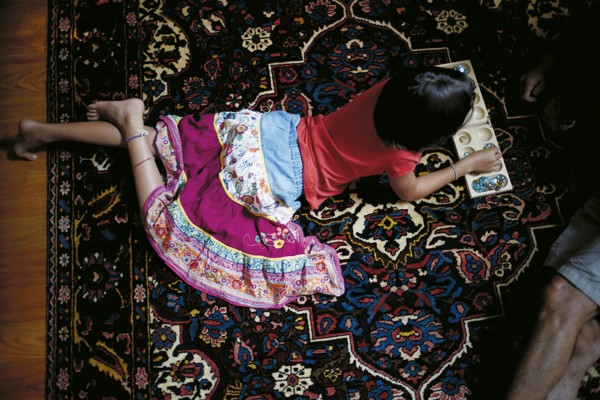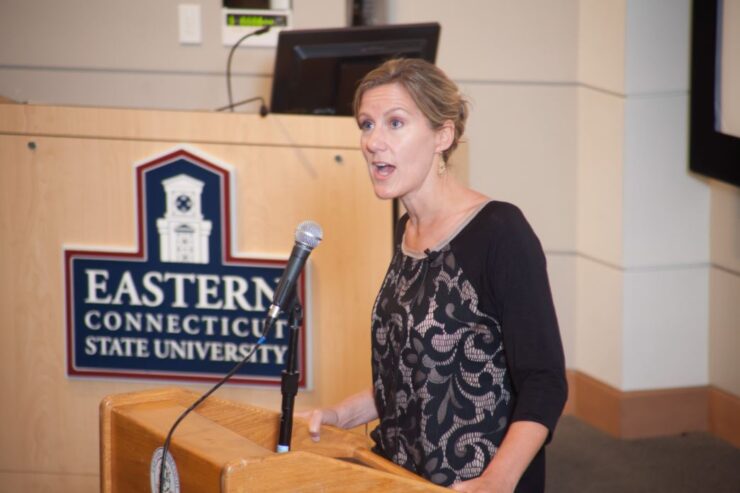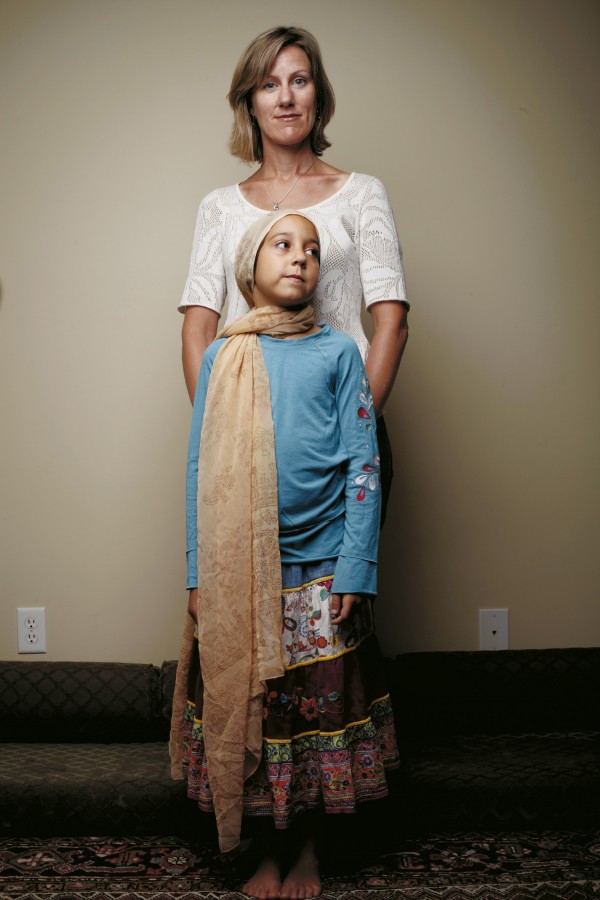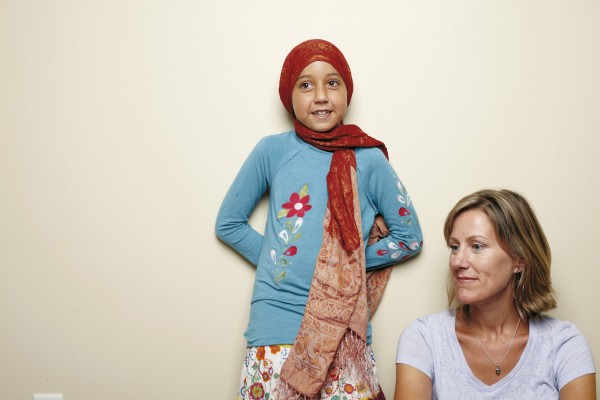Confident that her daughter would follow in her footsteps while growing up, Krista Bremer was surprised when Aliya decided to wear the headscarf instead — at the tender age of nine.
Nine years ago, I danced my newborn daughter around my North Carolina living room to the music of Free to Be . . . You and Me, the 70s children’s classic whose every lyric about tolerance and gender equality I had memorised as a girl growing up in California.
My Libyan-born husband, Ismail, sat with her for hours on our screened porch, swaying back and forth on a creaky metal rocker and singing old Arabic folk songs, and took her to a Muslim sheikh who chanted a prayer for long life into her tiny, velvety ear.

She had espresso eyes and lush black lashes like her father’s, and her milky-brown skin darkened quickly in the summer sun. We named her Aliya, which means ‘exalted’ in Arabic, and agreed that we would raise her to choose what she identified with most from our dramatically-different backgrounds.
I secretly felt smug about this agreement — confident that she would favour my comfortable American lifestyle over his modest Muslim upbringing. Ismail’s parents live in a squat stone house down a winding dirt alley outside Tripoli, Libya. Its walls are bare except for passages from the Qur’an engraved on to wood, its floors empty but for thin cushions that double as bedding.
My parents live in a sprawling home in Santa Fe, New Mexico, with a three-car garage, hundreds of channels on the flat-screen television, organic food in the refrigerator and a closet full of toys for the grandchildren.
I imagined Aliya embracing shopping trips to Whole Foods and the stack of presents under the Christmas tree, while still fully appreciating the melodic sound of Arabic, the honey-soaked baklava Ismail makes from scratch, and the intricate henna tattoos her aunt draws on her feet when we visit Libya. Not once did I imagine her falling for the head covering worn by Muslim girls as an expression of modesty.

Last summer we were celebrating the end of Ramadhan with our Muslim community at a festival in the car park behind our local mosque. Children bounced in inflatable fun houses while their parents sat beneath a plastic tarpaulin nearby, shooing flies from plates of curried chicken, rice and baklava.
Aliya and I wandered past rows of vendors selling prayer mats, henna tattoos, and Muslim clothing. When we reached a table displaying head coverings, Aliya turned to me and pleaded, ‘Please, Mom — can I have one?’ She riffled through neatly-folded stacks of headscarves while the vendor, an African-American woman shrouded in black, beamed at her.
I had recently seen Aliya cast admiring glances at Muslim girls her age. I quietly pitied them, covered in floor-length skirts and long sleeves on even the hottest days. My best childhood memories were of my skin laid bare to the sun: feeling the grass between my toes as I ran through the sprinkler on my front lawn; wading into an icy river in Idaho, my shorts hitched up to my thighs, to catch my first rainbow trout; surfing a rolling emerald wave off the coast of Hawaii. But Aliya envied these girls and had already asked me to buy her clothes like theirs. And now, a headscarf.
In the past, my excuse was that they were hard to find, but here she was, offering to spend $10 from her allowance to buy the forest green rayon one she clutched in her hand. I started to shake my head, but caught myself, remembering my commitment to Ismail. So I gritted my teeth and bought it, assuming it would soon be forgotten.
That afternoon, as I was leaving for the grocery store, Aliya called out from her room that she wanted to come
A moment later she appeared at the top of the stairs—or, more accurately, half of her did. From the waist down, she was my daughter: sneakers, bright socks, jeans a little threadbare at the knees. But from the waist up, this girl was a stranger.
Her bright, round face was suspended in a tent of dark cloth like a moon in a starless sky.
‘Are you going to wear that?’
‘Yeah,’ she said slowly, in the tone she had recently begun to use with me.
On the way to the store, I stole glances at her in my rearview mirror. She stared out the window, appearing as aloof and unconcerned as a Muslim dignitary visiting our small Southern town—I merely her chauffeur.
I bit my lip. I wanted to ask her to remove her head covering before she got out of the car, but I couldn’t think of a single, logical reason why, except that the sight of it made my blood pressure rise. I’d always encouraged her to express her individuality and to resist peer pressure, but now I felt as self-conscious and claustrophobic as if I were wearing that headscarf myself.
In the supermarket car park, the heavy summer air smothered my skin. I gathered the damp hair on my neck into a ponytail, but Aliya seemed unfazed by the heat. We must have looked like an odd pair: a tall blonde woman in a tank top and jeans cupping the hand of a 1.2m-tall Muslim. I drew my daughter closer and the skin on my bare arms prickled – as much from protective instinct as from the blast of refrigerated air that hit me as I entered the store.
As we manoeuvred our trolley down the aisles, shoppers glanced at us as if we were a riddle that they couldn’t quite solve, quickly dropping their gaze when I caught their eye.

In the produce aisle, a woman reaching for an apple fixed me with an overly bright, solicitous smile that said: ‘I embrace diversity and I am perfectly fine with your child.’ She looked so earnest, so painfully eager to put me at ease, that I suddenly understood how it must feel to have a child with an obvious disability, and all the curiosity or unwelcome sympathies from strangers that it evokes.
At the checkout, an elderly Southern woman clasped her bony hands together and bent slowly down towards Aliya.
‘My, my,’ she drawled, wobbling her head in disbelief. ‘Don’t you look absolutely precious!’ My daughter smiled politely, then turned to ask me for a pack of chewing gum.
In the following days, Aliya wore her headscarf to the breakfast table over her pyjamas, to a Muslim gathering where she was showered with compliments, and to the park, where the mothers I chatted to studiously avoided mentioning it.
Later that week, at our local pool, I watched a girl only a few years older than Aliya play table tennis with a boy her age. She was caught in that awkward territory between childhood and adolescence—narrow hips, skinny legs, the slightest swelling of new breasts—and she wore a string bikini.
Her opponent wore an oversized t-shirt and baggy trunks that fell below his knees. When he slammed the ball at her, she lunged for it while trying with one hand to keep the slippery strips of spandex in place. I wanted to offer her a towel to wrap around her hips, so that she could lose herself in the contest and feel the exhilaration of making a perfect shot.
It was easy to see why she was getting demolished at this game: her near-naked body was consuming her focus. And in her pained expression I recognised the familiar mix of shame and excitement that I felt when I first wore a bikini.
At 14, I skittered down the halls of high school like a squirrel in traffic: hugging the walls, changing direction in midstream, darting for cover. Then I went to Los Angeles to visit my Aunt Mary during winter break. Mary collected mermaids, kept a black-and-white photo of her long-haired Indian guru on her dresser and shopped at a tiny health food store that smelled of patchouli and peanut butter. She took me to Venice Beach, where I bought a cheap bikini from a street vendor.
Dizzy with the promise of an impossibly bright afternoon, I thought I could be someone else—glistening and proud like the greased-up bodybuilders on the lawn, relaxed and unselfconscious as the hippies who lounged on the footpath with lit incense tucked behind their ears. In a beachside bathroom with gritty cement floors, I changed into my new suit.
Goose bumps spread across my chubby white tummy and the downy white hairs on my thighs stood on end; I felt as raw and exposed as a turtle stripped of its shell. And when I left the bathroom, the stares of men seemed to pin me in one spot.
In spite of a strange and mounting sense of shame, I was riveted by their smirking faces; in their suggestive expressions I thought I glimpsed some vital clue to the mystery of myself. What did these men see in me? What was this strange power surging between us, this rapidly shifting current that one moment made me feel powerful and the next, unspeakably vulnerable?

I imagined Aliya in a string bikini in a few years. Then I imagined her draped in Muslim attire. It was hard to say which image was more unsettling. I thought then of something a Sufi Muslim friend had told me: that Sufis believe our essence radiates beyond our physical bodies—that we have sort of an energetic second skin, which is sensitive and permeable to everyone we encounter. Muslim men and women wear modest clothing, she said, to protect this charged space between them and the world.
Growing up in Southern California in the 70s, I had learnt that freedom for women meant, among other things, fewer clothes, and that women could be anything—and still look good in a bikini. Exploring my physical freedom had been an important part of my self-discovery, but the exposure had come at a price.
Since that day in Venice Beach, I’d spent years learning to swim in the turbulent currents of attraction: wanting to be desired, resisting unwelcome advances, plumbing the mysterious depths of my own longing. I’d spent countless hours studying my reflection in the mirror—admiring it, hating it, wondering what others thought of it—and it sometimes seemed to me that if I had applied the same relentless scrutiny to another subject, I could have become enlightened, written a novel, or at least figured out how to create an organic vegetable garden.
On a recent Saturday morning, in the crowded dressing room of a large department store, I tried on designer jeans alongside college girls in high, spiky heels, young mothers with babies fussing in their pushchairs, and middle-aged women with glossed lips pursed into frowns. One by one we filed into changing rooms, then lined up to take our turn on a brightly lit pedestal surrounded by mirrors, cocking our hips and sucking in our tummies and craning our necks to stare at our rear ends.
When it was my turn, my heart felt as tight in my chest as my legs did in the jeans. My face looked drawn under the fluorescent lights, and suddenly I was exhausted by all the years I’d spent doggedly chasing the carrot of self-improvement, while dragging behind me a heavy cart of self-criticism.
At this stage in her life, Aliya is captivated by the world around her, not by what she sees in the mirror. Last summer she stood at the edge of the Blue Ridge Parkway, stared at the blue-black outline of the mountains in the distance, their tips swaddled by cottony clouds, and gasped. ‘This is the most beautiful thing I ever saw,’ she whispered. Her wide-open eyes were a mirror of all that beauty, and she stood so still that she blended into the lush landscape, until finally we broke her reverie by pulling her back to the car.
At school it’s different. In her fourth-grade class, girls already draw a connection between clothing and popularity. A few weeks ago, her voice rose in anger as she told me about a classmate who had ranked all the girls in class according to how stylish they were.
I understood then that while physical exposure had liberated me in some ways, Aliya could discover an entirely different type of freedom by choosing to cover herself.
I have no idea how long Aliya’s interest in Muslim clothing will last. If she chooses to embrace Islam, I trust that the faith will bring her tolerance, humility and a sense of justice – the way it has done for her father. And because I have a strong desire to protect her, I will also worry that her choice could make life in her own country difficult. She has recently memorised the fatihah, the opening verse of the Qur’an, and she is pressing her father to teach her Arabic. She’s also becoming an agile mountain biker who rides with me on wooded trails, mud spraying her calves as she navigates swollen creeks.

The other day, when I dropped her off at school, instead of driving away in a rush as I usually do, I watched her walk into a crowd of kids, bent forward under the weight of her backpack as if she were bracing against a storm. She moved purposefully, in such a solitary way, so different from the way I was at her age, and I realised once again how mysterious she is to me.
It’s not just her head covering that makes her so: it’s her lack of concern for what others think about her. It’s finding her stash of Halloween candy untouched in her drawer, while as a child I was obsessed with sweets. It’s the fact that she would rather dive into a book than into the ocean; that she gets so consumed with her reading that she can’t hear me calling her from the next room.
I watched her kneel at the entryway to her school and pull a neatly folded cloth from the front of her pack, where other kids stash bubble gum or lip gloss. Then she slipped it over her head, and her shoulders disappeared beneath it like the cape her younger brother wears when he pretends to be a superhero.
I imagined that headscarf having magical powers to protect her boundless imagination, her keen perception and her unselfconscious goodness. I imagined it shielding her as she journeys through that house of mirrors where so many young women get trapped in adolescence, buffering her from the dissatisfaction that clings in spite of the growing number of choices at our fingertips, providing safe cover as she takes flight into a future I can only imagine.
Award-winning American writer Krista Bremer is married to a Libyan-born Muslim. Her poignant personal essays are written from the heart and articulated with an intelligent, open mind in an effortless style that has captivated followers the world over. Insights into their bicultural union have also won her fans in the Muslim circles who identify with the tribulations and celebrations that Krista, an epitome of the urban woman—confident, successful, tolerant, strong and smart—faces in her day-to-day dealings with Islam and modern living. She is the winner of the 2008 Pushcart Prize and the 2009 Rona Jaffe Foundation Writers’ Award, is associate publisher of literary magazine The Sun, and is writing a memoir about her bicultural marriage.
© 2010 Krista Bremer. Pictures by Michael McGregor
This article originally appeared in the September/October 2011 issue of Aquila Style magazine
